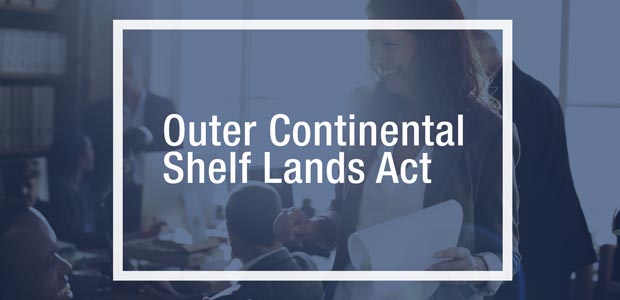Outer Continental
Shelf Lands Act
If you are hurt on the job, we are the team that can help you.Barry R. Lerner

Outer Continental
Shelf Lands Act
As anyone who works offshore or has family working offshore is aware, working in the industry comes with various inherent risks that the majority of the world’s workforce will never face. Enacted in 1953, the Outer Continental Shelf Lands Act extended the workers’ compensation benefits found in the Longshore and Harbor Workers’ Compensation Act (Longshore Act) to employees who are injured as a result of operations conducted on the outer Continental Shelf for the purpose of exploring, developing, removing or transporting by pipeline the natural resources of the outer Continental Shelf. Most commonly, the Outer Continental Shelf Lands Act applies in cases where oil and gas workers have been injured or died while working on a fixed or floating platform on the outer Continental Shelf.
The purpose of this Outer Continental Shelf Lands Act is to provide the workers’ compensation benefits found under the Longshore Act to:
- A covered employee who was injured offshore;
- A covered employee’s dependents in the event that the injury caused the employee’s death; and
- A covered employee who suffers from an occupational disease.
These benefits may include lost wage, medical, and death benefits. Like the Longshore Act, claims under the Outer Continental Shelf Lands Act are administered by the United States Department of Labor Office of Workers’ Compensation Programs.
The Outer Continental Shelf Lands Act is a federal law that varies both substantively and procedurally from common state workers’ compensation law. However, depending on the location of the accident, it is possible that an offshore accident falls under the jurisdiction of the nearest state. Determining which workers’ compensation laws apply can be challenging. For this reason, it is important to consult with a specialized offshore injury attorney such as the attorneys at Barnett, Lerner, Karsen, Frankel & Castro, P.A. who have nationwide experience with claims under the Outer Continental Shelf Lands Act.
Longshore and Harbor Workers Navigation
Dedicated To You
We are dedicated to making sure you receive the justice you deserve for your case.
Experienced
With over 90 years of collected experience we are able to take on almost any case.
Conditions for Coverage under the Outer Continental Shelf Lands Act
As described above, the Outer Continental Shelf Lands Act applies to employees who were injured or who died as a result of work conducted on the outer Continental Shelf. While the technical definition of the Outer Continental Shelf is quite nuanced; simply described, the outer Continental Shelf is submerged land that lies outside state coastal waters, but that is still within U.S. jurisdiction.
Coverage under the Outer Continental Shelf Lands Act applies in cases including, but not limited to:
- Injuries that happened on drilling platforms, oil rigs, artificial islands, or other fixed structures located on artificial islands, and
- Injuries caused by structure or devices on the outer Continental Shelf.
It is possible for employees injured onshore to have a claim under the Outer Continental Shelf Lands Act. In 2012, the U.S. Supreme Court held that an employee injured on kill onshore is eligible for benefits under the Outer Continental Shelf Lands Act if the employee can establish “a significant causal link between the injury he suffered and his employer’s on-OCS extractive operations.”
Importantly, the Outer Continental Shelf Lands Act does not cover individuals employed by the government or individuals who were crewmembers on a vessel. In these instances other remedies provided under the Jones Act, state liability laws, or other maritime laws may be available.
If you are interested in reading the entire Outer Continental Shelf Lands Act, please click here.
Benefits under the Outer Continental Shelf Lands Act
Being seriously injured in a work-related accident is scary and trying to determine what benefits you are entitled to can be confusing and can cause unneeded stress. If you have been injured in a work-related accident all you energy should be focused on healing. The attorneys at Barnett, Lerner, Karsen, Frankel & Castro, P.A. are experienced with claims under the Outer Continental Shelf Lands Act and will help reduce your stress by navigating the complexities of your claim so that you can focus on getting better.
By extension of the Longshore Act, the benefits provided under the Outer Continental Shelf Lands Act include both employment-related injury and death benefits.
Medical

Medical benefits include “all medical, surgical, and hospital treatment and other medical supplies and services” related to the injury. Expenses can include hospital and doctor’s visits, medications, surgeries, and medical devices. Also covered are the required costs associated with travel and mileage for obtaining the medical care. Injured employees are free to seek medical treatment from a physician of their choice, so long as that physician is approved to provide medical care by the Office of Workers’ Compensation Programs.
Medical
In the tragic instance of an employee’s death due to work-related injuries, his or her family members or other eligible survivors may be entitled to death benefits. While nothing can replace a lost loved one, it is important to review possible claims under the Non-Appropriated Funds Instrumentalities Act so that surviving family members receive all the benefits for which they are eligible.
- Funeral Expenses – Up to $3,000 of reasonable funeral expenses may be paid to an employee’s surviving family members.
- Additional Compensation – Surviving spouses receive 50 percent of the employee’s average weekly wage for the rest of his or her life, or until the surviving spouse remarries. If the deceased employee had children, additional compensation is provided at the rate of 16 2/3 percent of the employee’s average weekly wage. In cases where children are the sole survivors, 50 percent of the employee’s average weekly wage is paid with a 66 2/3 percent maximum if there are more than one child is entitled to benefits.
If you are interested in more detailed description of benefits available, please click here.
What you should do if you are Injured
Timing is very important when beginning a claim for benefits under the Non-Appropriated Funds Instrumentalities Act. An employee, or his survivors, must provide written notice of an injury or death within 30 days of the date of the injury. Additionally, written claims for compensation must generally be filed with the Office of Worker’s Compensation Programs within one year of the injury.
Our Videos
Would you like to learn more? Still need a little more information? Our videos may help.
Get Started
Work with a team that cares about you. Our team has the experience and dedication to get you the justice you deserve.
